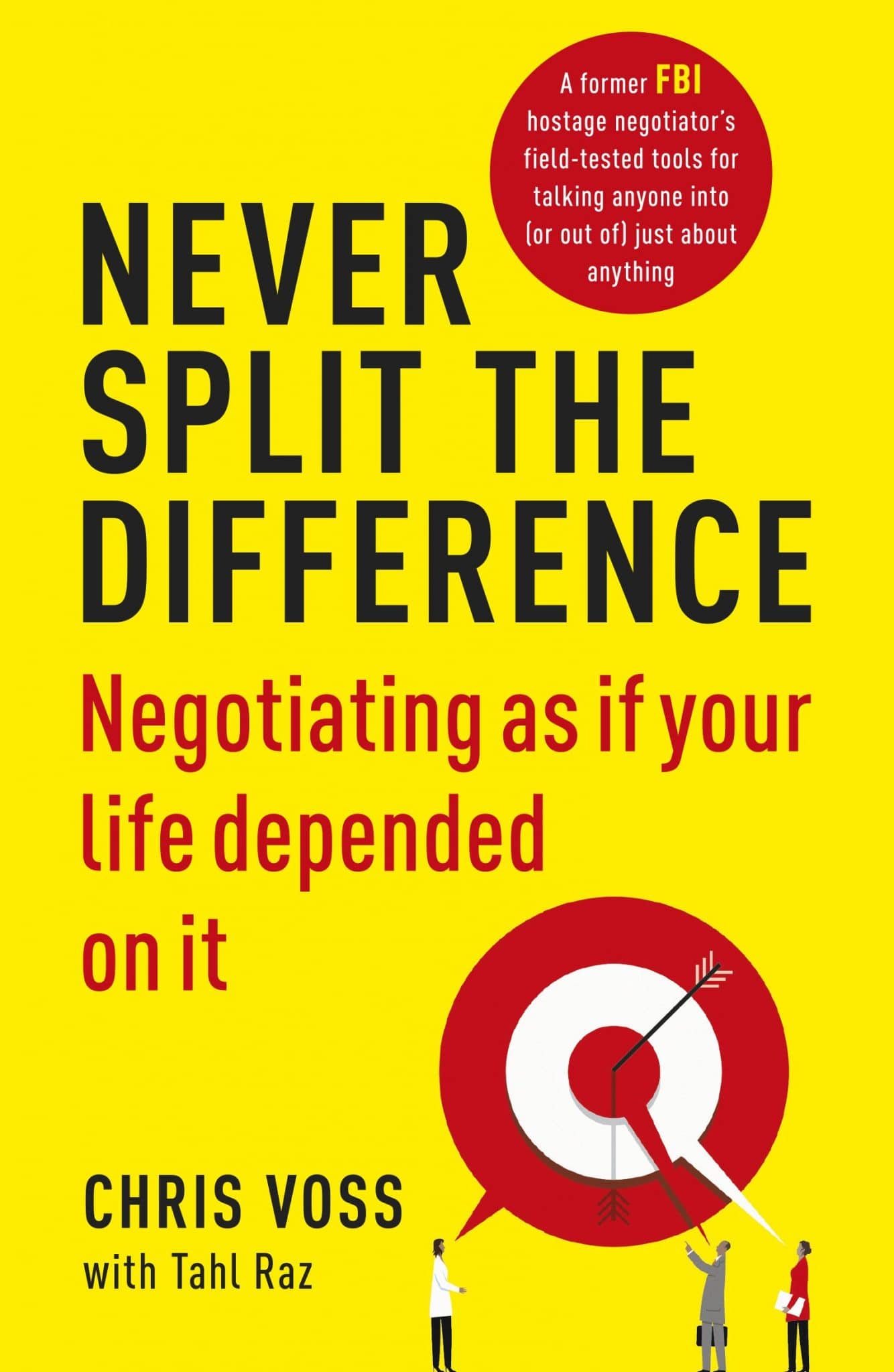- Author: Tahl Raz, Chris Voss
- Publisher: Harper Business
- Rating: ⭐⭐⭐⭐
- Link Amazon : Book Never split the difference
- Pages: 288
- Time to Read: 46 Days
🚀 The Book in 3 Sentences
- The most important thing in a negotiation is to listen
- Try to find the Black Swans (Unknown Unknowns) in every negotiation
- three
🕵🏼Who Should Read It?
There is probably no person on which this book is not able to be beneficial if read. The skill of negotiation can be applicable to everyone's life since negotiations don’t happen just in a business context. The well and easy writing style of Tahl Raz is very pleasing which guarantees a pleasant reading experience. Also, the summaries at the end of each chapter help remember the book's content and rereading.
☘️ How the Book Changed Me
Since this book was the first book I read about negotiating, it consisted of a lot of valuable information. The negotiation strategies taught in this book are very reasonable and socially acceptable as well, since the goal is not only to reach a certain price point but also to manage and build a good connection with your negotiating partner. All through the book, interesting and applicable examples are provided, which can help improve the understanding of the book's content and strategies.
✍️ My Top 3 Quotes
“Negotiation is not an act of battle; it’s a process of discovery.” Chris Voss
“Know the emotional drivers and you can frame the benefits of any deal in language that will resonate.” Chris Voss
“No, is the start of the negotiation, not the end of it.” Chris Voss
📒 Summary + Notes
1. How to establish Rapport and build Empathy
To negotiate over something with a pretty much unknown person, it is important to gather information. This can best be done through listening. Psychotherapy has shown that when individuals feel listened to, they tend to listen to themselves more carefully. This also means that people evaluate and clarify their own thoughts and feelings better.
Once the listening part is done correctly, it is important to build rapport with the negotiating partner. To accomplish this, there is a simple process that can be followed for reaching success.
-
Use the late-night FM DJ voice.
-
Start with “I’m sorry . . .”
-
Mirror.
-
Silence. At least four seconds, to let the mirror work its magic on your counterpart.
-
Repeat.
The late-night FM DJ voice can be used to sound calm, assertive, and sure about what you do. It can be accomplished by inflecting your voice in a downward way.
Mirroring in step 3 is also called isopraxism, and it is the process of essentially imitating the other person. Humans and other animals do that to comfort each other. Isopraxism can happen verbally but also non-verbally, for example, with body language. In a negotiation, mirroring is when you repeat what the other person said.
2. Beware “YES”—master “NO”
A very interesting thing taught in the book is that a negotiator should beware of a "yes" and instead try to accomplish a "no". Because most of the time, "yes" can have multiple meanings. "Yes" can be a counterfeit, which means that the "yes" is often followed by a "no", but saying "yes" was the easier option. "Yes" can also be a confirmation, which has no real effect on the negotiation, or a "yes" can be a commitment, which is the desired response. The problem is that you have to be able to know which "yes" you received, and that can sometimes be challenging.
"No", on the other hand, is much simpler and easier to say because most of the time it means one of the following things:
- I am not yet ready to agree
- You are making me feel uncomfortable
- I do not understand
- I don’t think I can afford it
- I want something else
- I need more information
- I want to talk it over with someone else.
After you hear a 'no', you can then ask questions about why it doesn’t work for them and what the problem is. This leads to gaining information and a better understanding of the other person.
As you can see, “No” has a lot of skills
- “No” allows the real issues to be brought forth;
- “No” protects people from making—and lets them correct—ineffective decisions;
- “No” slows things down so that people can freely embrace their decisions and the agreements they enter into;
- “No” helps people feel safe, secure, emotionally comfortable, and in control of their decisions;
- “No” moves everyone’s efforts forward.
3. How to get permission to persuade
Since a 'yes' does not always mean the 'yes' you are hoping for, it is generally much better to try to achieve a 'that’s right'. This phrase is where the magic happens and represents that you are on the right track. But be careful about 'you are right', since this is mostly used to signal the end of the conversation. Because most of the time, there is nothing to be discussed after one is perceived to be right. A 'that’s right' can be accomplished with a combination of labeling and mirroring.
4. How to shape what is fair
When trying to reach a good result in a negotiation, it is important to know some tips and tricks. It is good to know that although most people think they act on behalf of rational thinking, most decision-making is governed by emotions. This is important since humans are prone to reject unfairness. This keyword 'fairness' can be very powerful if used correctly. The authors explain that the word should be used when starting the conversation like this:
'I want you to feel like you are being treated fairly at all times. So please stop me at any time if you feel I’m being unfair, and we’ll address it.'
This sets you up as an honest dealer and creates a constructive environment. To not make this blog longer than it has to be, I will provide the next tips in a short format:
- Anchor their emotions: If you have negative news try to anchor the emotions so that when you say your offer it does not sound as bad.
- Establish a range: When negotiating for a price or salary try to talk in ranges to not force the counterpart into defensive mode.
- Pivot to non-monetary terms: This can make a negotiation reach a succesful end although not all parties agreed on monetary terms
- When talking numbers use odd ones: This makes the number seem calculated and fixed.
- Surprise with a gift: People are prone to respond to generosity with generosity.
5. Create the illusion of control
Another thing to do in a negotiation is using what are called calibrated questions. These can be used to say no in a non-confrontational way or make your counterpart understand your side without aggression or confrontation. Ask calibrated questions that start with “how” or “what”. For example:
-
What about this is important to you?
-
How can I help to make this better for us?
-
How would you like me to proceed?
-
What is it that brought us into this situation?
-
How can we solve this problem?
-
What’s the objective? / What are we trying to accomplish here?
-
How am I supposed to do that?
Also calibrate your questions to point your counterpart to solving your problem. This will make them finding a solution for your problem.
6. Guarantee execution
In this chapter, the authors talk about the importance of not only getting a yes but also talking about the how. Clarity on how something will be done or implemented can lead to a lower execution hurdle. In the context of investigation execution, the authors mention the 7-38-55 rule, which says that only 7 percent of a message is based on words, 38 percent on the tonality of your voice, and 55 percent on your body language and face. Understanding your counterpart's body language can also greatly increase your possibility of catching them lying since a disparity between words and body language exists when someone is lying.
7. Bargaining hard
This chapter is about how to reach a desired price in a negotiating situation.
-
Set your target price (your goal).
-
Set your first offer at 65 percent of your target price.
-
Calculate three raises of decreasing increments (to 85, 95, and 100 percent).
-
Use lots of empathy and different ways of saying “No” to get the other side to counter before you increase your offer.
-
When calculating the final amount, use precise, non round numbers like, say, 38,000. It gives the number credibility and weight.
-
On your final number, throw in a non-monetary item (that they probably don’t want) to show you’re at your limit.
8. Find the black swan
The black swan theory says that things happen which previously were thought to be impossible. In a negotiation, this theory suggests that there are unknown unknowns which, if brought to light, can be used as leverage. To uncover black swans, one has to see everything with a beginner's mind to not miss information due to our own perception.
The one sheet
This is a sheet that the authors suggest to prepare before every negotiation. This sheet helps you stick to your defined strategy and helps you keep memorising vital information.
The Goal
Think through best/worst-case scenarios but only write down a specific goal that represents the best case.
- Set an optimistic but reasonable goal and define it clearly.
- Write it down.
- Discuss your goal with a colleague (this makes it harder to wimp out).
- Carry the written goal into the negotiation.
- Carry the written goal into the negotiation.
Summary
Summarise and write out in just a couple of sentences the known facts that have led up to the negotiation.
Labels and accusation audits
Prepare three to five labels to perform an accusation audit.
It seems like _________ is valuable to you.
It seems like you don’t like _________.
It seems like you value __________.
It seems like _________ makes it easier.
It seems like you’re reluctant to _________.
Calibrated questions
Prepare three to five calibrated questions to reveal value to you and your counterpart and identify and overcome potential deal killers.
What are we trying to accomplish? How is that worthwhile? What’s the core issue here? How does that affect things? What’s the biggest challenge you face?
Additionally it makes sense to prepare questions to diffuse deal-killing issues or questions that unearth them.
Non cash offers
Prepare a list of non-cash items possessed by your counterpart that would be valuable.
I've made it this far, and I want to thank you for reading this blog. I hope you've learned as much about negotiations as I have. May you have many successful negotiations ahead, and I wish you all the best.
Regards Devin Hasler

